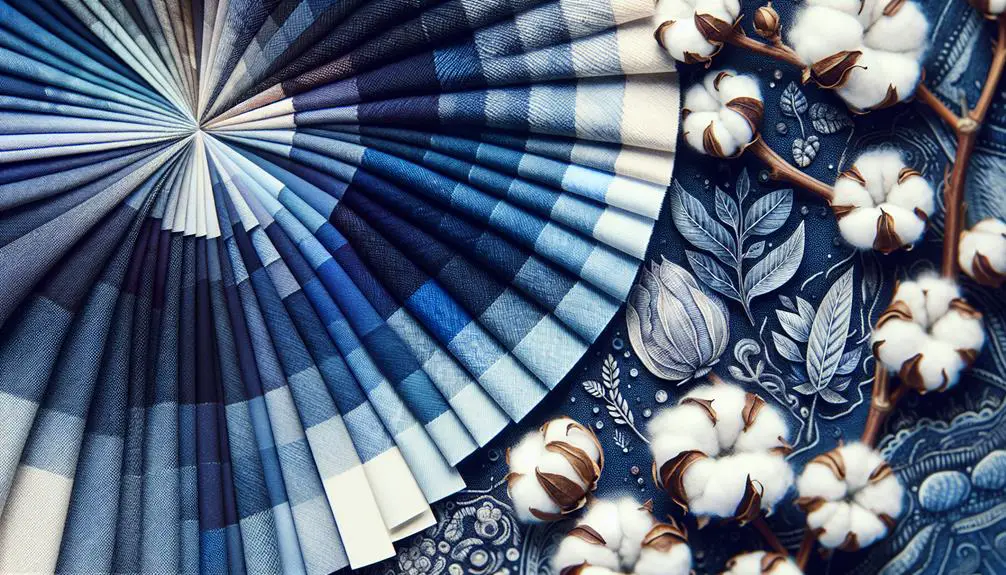I've always been fascinated by how things start, especially when it comes to fashion. So, it's no surprise that I got curious about denim's original color. Turns out, denim was first dyed with natural indigo, giving it that classic blue shade we all know and love. This blue wasn't just any blue, though; it was the result of a dye that came from plants, mainly found in India and Africa. But here's the kicker: the way denim fades over time has made it more than just clothing; it's a piece of history that evolves with us. Makes you wonder, how did we go from natural indigo to the denim we see today, right? Let's take a closer look at that journey.
Table of Contents
Key Takeaways
- Denim is originally dyed with natural indigo, giving it its classic blue color.
- The classic blue color of denim originates from traditional dyes used in India and Africa.
- The use of indigo dye is crucial for the cultural significance of denim's blue color.
- Synthetic indigo dye, invented in 1878, has also been used to maintain the classic blue color of denim.
- Over time, the blue indigo dye fades with washing, sunlight exposure, and wear, creating distinctive fading patterns.
History of Denim
Denim's journey started when it was first dyed with natural indigo, giving it that classic blue color we all know and love. This unique blue comes from indigo dye, originally sourced from India and Africa, which has a special way of bonding with cotton yarn. That's how denim gets its iconic look. It's not just any blue; it's a deep, rich shade that's become synonymous with the fabric itself.
Now, let's talk about a game-changing moment in denim's history. Levi Strauss and Jacob Davis, these guys were onto something big in 1873. They took this blue denim fabric and made the first pair of jeans with those famous rivets. Can you imagine? That was the start of something that would become a global obsession.
Over the years, sure, denim's been dyed all sorts of colors, but nothing beats that classic blue. It's more than just a color; it's a piece of history, a symbol of durability and style that's lasted through the ages. And it all started with indigo and cotton, simple as that.
The Birth of Serge De Nîmes
After exploring how indigo brought denim its classic blue, let's now look at a pivotal moment in its history: the birth of Serge De Nîmes in France. This is where the whole story of denim really kicks off. Serge de Nîmes wasn't just any fabric; it was a game-changer. Made from twill fabric and dyed with natural indigo from the indigofera tinctoria, it introduced the world to a durable, yet stylish material that could stand the test of time.
The process of indigo dyeing itself was fascinating. It transformed the original white or cream twill fabric into that iconic blue color we all know and love. And the fact that 'denim' is directly derived from 'serge de Nîmes' just shows how integral this French innovation was to what denim has become today.
About Indigo Dye
So, we're moving on to talk about indigo dye, the stuff that gives denim its iconic blue color.
I'll tell you about where it comes from, how it's made, and why it's so important in different cultures.
It's pretty cool how this dye has shaped the look and history of our jeans, right?
Origins of Indigo Dye
I've always been fascinated by how indigo dye, coming from plants like Indigofera, became the go-to color for denim. It's all about that deep blue shade that makes our jeans look so cool.
But it wasn't until synthetic indigo dye hit the scene in 1878 that things really took off. This invention was a game-changer for the denim industry, making it way cheaper to get that rich blue color.
What's super interesting is how indigo dye sticks to denim fabric. It's all about the twill weave and how the dye only coats the surface, leading to that iconic fading effect we all love.
Plus, denim makers can play around with the dye to create all sorts of denim hues, ensuring our jeans aren't just durable but also stylish.
Indigo Dyeing Process
Building on our understanding of indigo dye's significance, let's explore how it transforms denim with its distinctive blue shade. The dyeing process isn't just a simple dip; it's an art. We start with either natural or synthetic indigo, but the magic really kicks in during the dyeing. It's all about dipping the denim fabric into the dye and then letting it oxidize. This isn't a one-and-done deal; we repeat these steps to deepen those blue hues we all love.
| Step | Purpose |
|---|---|
| Dipping | Immerses fabric in dye |
| Oxidation | Exposes to air for color development |
| Repeating | Enhances intensity of blue |
| Fading | Creates iconic worn look |
This cycle of dipping and oxidation gives denim its character, making those fading properties a badge of honor.
Cultural Significance
Indigo dye's journey through history isn't just about color; it's a tale woven into the very fabric of cultures across the globe. Originally, this deep blue shade came from natural sources like the Indigofera plant, found in diverse places such as India, Africa, and the Americas.
By 1878, the game changed with the synthetic version of indigo dye, making it more accessible and transforming denim into what we know today. This dye isn't just crucial for giving denim its classic blue color; it's also behind the iconic appearance that defines our jeans. Its unique fading properties mean that over time, each piece of denim tells its own story, becoming more personalized.
The indigo dye really has given denim its soul, making it more than just clothing but a piece of cultural history.
Levi Strauss & Co. Origins
I've always been curious about how Levi Strauss & Co. kicked off the whole denim craze. It's fascinating that their use of indigo to dye denim not only changed fashion forever but also launched products that we now consider iconic.
Let's see how their founding year, the impact of the denim revolution, and the launch of those famous products all tie together.
Founding Year Insights
Back in 1853, Levi Strauss & Co. kicked off its journey in San Francisco, California, setting the stage for the denim revolution.
Partnering up with Jacob Davis in 1873, they patented something game-changing: riveted denim pants. You've probably heard of 'em as waist overalls, the granddaddy of today's jeans.
And that iconic blue denim color? It's all thanks to natural indigo dye.
Honestly, Levi Strauss & Co. wasn't just about making clothes; they were about crafting durable, reliable workwear fabric that could handle anything. Their mission? To arm the everyday worker with gear that wouldn't quit.
And let me tell you, they nailed it with those riveted denim pants.
Denim Revolution Impact
In 1873, Levi Strauss & Co. revolutionized workwear by launching durable denim pants with rivets, changing the game for laborers everywhere. This was huge! Imagine, back in the Gold Rush era, miners had it tough. They needed clothes that could take a beating and not fall apart. That's where Levi Strauss & Co. stepped in.
By adding those clever little rivets to key stress points on pants, they made them last way longer. Plus, that deep blue hue from the indigo dye? It didn't just look cool; it helped hide dirt and stains, making the pants practical for hard work. This wasn't just a new style; it was a denim revolution.
Levi Strauss & Co. didn't just make clothes; they made workwear that could stand up to the challenge.
Iconic Products Launch
Levi Strauss & Co. kicked off a fashion revolution in 1873 by patenting the first pair of blue jeans, setting a new standard in workwear. It was a game-changer, really. They brought something totally new to the table with these pants made from denim, dyed in natural indigo to get that perfect blue.
Here's why it was such a big deal:
- The collaboration with Jacob W introduced denim strengthened with copper rivets, making them super durable.
- Twilled cotton was chosen for its toughness and comfort, ideal for hard-wearing pants.
- This move cemented Levi Strauss & Co.'s place as pioneers in the fashion industry, with blue jeans becoming a symbol of durability and style.
Denim's Evolution in Fashion
Denim's shift from sturdy workwear to a fashion icon really kicked off when Hollywood legends like Marlon Brando and James Dean made it cool.
Originally, this durable cotton twill fabric was dyed with indigo, giving it that classic deep blue. But it wasn't just the color that caught everyone's eye; it was how these Hollywood icons wore them.
Suddenly, denim wasn't just for hard work; it was a symbol of rebellion, a nod to the counterculture movement that was brewing.
Why Denim Fades
While we've seen how denim became a fashion staple, let's now explore why it fades over time. The key to this phenomenon lies in the indigo dye used in original denim. Unlike other dyes that penetrate fabric deeply, indigo only clings to the outermost threads. This unique characteristic leads to the distinctive fading pattern denim is famous for, but why exactly does this happen?
- Indigo Dye and Fading: The indigo dye doesn't fully penetrate the fabric; it only binds to the surface. Because of this, every time you wash your denim, a bit of that color peels away. It's like slowly rubbing off layers of paint from a wall.
- Chemical Reaction: There's a chemical reaction happening every time your denim goes through a wash. This reaction causes the indigo dye to break down, leading to the fading over time. It's not just washing; exposure to sunlight and even the oils from your skin contribute to this process.
- Rough Parts and Fabric Softening: The areas that fade the fastest are usually the ones that get the most wear and tear – think of the knees, the thighs, and the seat. As the fabric softens and those rough parts rub against other surfaces, more indigo peels away, enhancing the fading effect.
The Future of Denim
As we look ahead, the future of denim is shaping up to be much greener, thanks to the rising demand for sustainable practices. Folks are getting savvy about what they wear, pushing brands to rethink how they make our beloved jeans. It's all about sustainable denim now, with both high-end and fast-fashion lines jumping on board. They're tweaking their production processes to be kinder to our planet. It's not just a trend; it's a shift towards an environmentally friendly way of making the stuff we love to wear.
What's really cool is seeing how denim manufacturing is getting a green makeover. We're talking about cutting-edge tech that slashes the ecological footprint of our denim, making it easier on the earth. This doesn't mean we're losing the classic styles we're all nuts about. Nope, it's more like we're getting the best of both worlds: premium denim that's also good for the planet.
With more of us asking for eco-conscious options, the denim industry is pivoting to a future where green is the norm. It's a win-win for everybody—us, the brands, and the big blue planet we call home.
Frequently Asked Questions
What Is the Original Color of Denim?
I've always known denim's original color is dark blue. That's because they used natural indigo to dye it. It's what gives denim its classic look. Really, that deep blue is what makes denim, well, denim.
What Color Is Denim Naturally?
I've learned denim's naturally dyed blue with indigo, giving it that classic look. This blue fades over time, creating unique patterns. Since 1878, they've used synthetic indigo, making it cheaper to produce.
What Is the Default Color of Jeans?
I've learned that the default color of jeans is a deep blue. This is because they're usually dyed with indigo, a natural dye that gives them their classic blue shade from the start.
Is Denim Blue or Grey?
I've learned that denim's original color is actually blue, not grey. This comes from the indigo dye they use to make it. So, whenever you're picking out jeans, you're mostly seeing that classic blue shade.
- How Does Ring Spun Cotton Affect Garment Fit and Shape Retention? - August 13, 2024
- What Are the Challenges in Producing Ring Spun Cotton? - August 13, 2024
- Is Ring Spun Cotton Suitable for Plus-Size Clothing? - August 13, 2024







